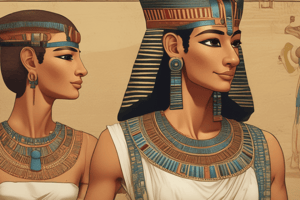Podcast
Questions and Answers
What was the primary belief regarding the Pharaoh's divine status in ancient Egyptian culture?
What was the primary belief regarding the Pharaoh's divine status in ancient Egyptian culture?
- He ruled with the approval of lesser gods.
- He ruled as a mortal leader.
- He embodied the divine will and considered himself a deity. (correct)
- He was considered entirely human with no divine influence.
Which of the following best describes the nature of Egyptian art?
Which of the following best describes the nature of Egyptian art?
- Simple and spontaneous
- Rich, rigid, and conservative (correct)
- Innovative and experimental
- Dynamic and expressive
What role did the aristocracy play in relation to the Pharaoh's authority?
What role did the aristocracy play in relation to the Pharaoh's authority?
- They were entirely disconnected from political power.
- They undermined the royal court.
- They challenged the Pharaoh's rule.
- They assisted the Pharaoh by enforcing order and security. (correct)
How did Egyptian artists learn their craft?
How did Egyptian artists learn their craft?
What was the primary purpose of creating art in ancient Egypt?
What was the primary purpose of creating art in ancient Egypt?
What was a key characteristic of the representation of human figures in Egyptian art?
What was a key characteristic of the representation of human figures in Egyptian art?
Which of the following statements is true regarding the beliefs about the dead in ancient Egypt?
Which of the following statements is true regarding the beliefs about the dead in ancient Egypt?
What role did the Pyramids play in Egyptian society?
What role did the Pyramids play in Egyptian society?
What was the main purpose of Egyptian art?
What was the main purpose of Egyptian art?
How were men and women represented differently in Egyptian art?
How were men and women represented differently in Egyptian art?
What was the significance of the frontal view of the eye in Egyptian art?
What was the significance of the frontal view of the eye in Egyptian art?
What was the rule concerning the representation of a man's shoulders in Egyptian art?
What was the rule concerning the representation of a man's shoulders in Egyptian art?
What was the purpose of painted images of servants in the tombs?
What was the purpose of painted images of servants in the tombs?
Which aspect of human representation was considered most important in Egyptian art?
Which aspect of human representation was considered most important in Egyptian art?
Why was the body measured in specific dimensions in Egyptian art?
Why was the body measured in specific dimensions in Egyptian art?
What did the Egyptians believe about the role of painters in creating art?
What did the Egyptians believe about the role of painters in creating art?
Flashcards are hidden until you start studying
Study Notes
Nature of Egyptian Art
- Characterized as rich, rigid, and conservative, demonstrating a consistent aesthetic from 3000 to 500 BC.
- The foundation of Egyptian institutions, beliefs, and artistic ideas was established in the early centuries.
Pharaoh's Divine Authority
- Pharaohs ruled by asserting divine rights: “BY THE GRACE OF GOD” and “IN THE NAME OF GOD.”
- Considered themselves embodiments of a deity, demanding obedience from their subjects.
- Authority was supported by an elite ruling class; aristocracy enforced order and received goods in return.
Beliefs About the Afterlife
- Egyptians viewed the Pharaoh as the son of Ra, their principal god.
- Art and architecture, such as pyramids, were created to last for eternity and serve the dead in the afterlife.
- Graves were modeled as replicas of daily life environments for the deceased's spirit, ensuring comfort for Ra.
Artistic Conventions
- Egyptian art was bound by strict canons learned from youth, limiting individual artistic expression.
- Focus was on the most characteristic representation, rather than visual perspective.
- Painters used specific conventions:
- Men depicted with darker skin than women.
- Pharaohs and queens always represented as beautiful, youthful, and thin.
- Proportions were standardized (e.g., men’s shoulders: 6 fists wide; women’s: 5 fists wide).
Representation Techniques
- Human figures were drawn to showcase recognizable features:
- Heads in profile with frontal eyes; arms and legs viewed from the side.
- Body proportions based on fixed conventions, ensuring consistent portrayals.
Purpose of Art
- Egyptian art was created with a magical purpose for the dead, aiming to ensure the presence of the soul in the afterlife.
- Artworks served functional, not aesthetic purposes; they were not intended for the enjoyment of the living.
Evolution of Burial Customs
- Originally, slaves and servants were sacrificed to accompany powerful individuals in death.
- This practice evolved; painted images of servants were instead created to provide the deceased with companionship and comfort.
Artistic Documentation
- Relief sculptures and wall paintings vividly represented the life and pleasures of the deceased, documenting significant life events.
- Egyptian painters followed rules that prioritized completeness of representation over aesthetic beauty.
Studying That Suits You
Use AI to generate personalized quizzes and flashcards to suit your learning preferences.




